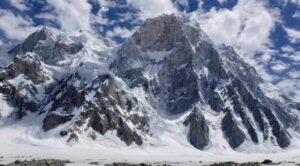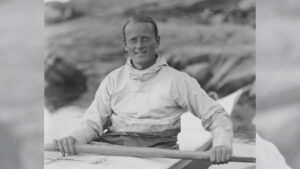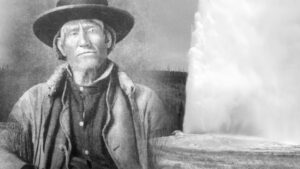In 1719, James Knight and his 40 men overwintered on a small island in Hudson Bay and were never seen again. Were they captured by the French? Assimilated by the Inuit?
I’ve always been intrigued by Arctic explorers who seem to have vanished off the face of the earth. My various attempts to discover what might have happened to them have turned out to be acts of exploration themselves. I follow in their footsteps or paddle strokes to some off-the-map locale, perhaps suffer the same inclement weather that they may have suffered, and hang out with Native elders who often seem to know stories about them.
Among missing Arctic explorers, Sir John Franklin immediately comes to mind. With his sagging jowls and general portliness, not to mention his habit of constantly toting a Bible, he resembles a retired English vicar far more than an arctic explorer. Even so, his disappearance has made him a celebrity even among people who, if asked to find the Northwest Passage on a map, might scratch their heads in bafflement.
As for myself, I prefer lost explorers uncelebrated by the media, such as Captain James Knight. With his two ships the Albany and the Discovery, Knight left England in 1719 to search for that ever-popular geographic magnet, the Northwest Passage, then known as the Straits of Annian. He decided to overwinter on Marble Island, an uninhabited fastness of white quartzite in western Hudson Bay. After all, it had perhaps the best harbor in those parts. And neither he nor his 40 crewmen were ever heard from again. Were they killed by Inuit? Assimilated by Inuit? Did they fall through the ice while trying to make it to the mainland? Or might they have come down with some virulent disease?
Once upon an earlier time, I joined Bill Gawor from Rankin Inlet and Fred Ford from Baker Lake on an expedition to Marble Island. We investigated the Knight house site, which consisted of a foundation and numerous scattered bricks, but found nothing that might have given us a clue about Knight and his missing men. We searched for but did not find a graveyard, although explorer Samuel Hearne claimed to have found a large one on the island in 1767. At one point Bill found a stanchion of stout English oak that may (or may not) have belonged to one of Knight’s ships.

An old ship’s stanchion, Marble Island. Photo: Lawrence Millman
Marble Island’s whiteness can easily camouflage a polar bear, with the result that a person might think they’re stepping on quartzite, but then that quartzite will rise up and smite them. Thus the three of us carried rifles with us almost all of the time. At one point I saw a large white form seemingly moving in my direction, and I quickly raised my rifle. The white form turned out to be snow being blown off one of our tents by a typically vigorous Hudson Bay wind. Later Fred scared off a polar bear with a warning shot from his rifle, then remarked with a grin, “I wonder if a polar bear killed off all of Knight’s men…”

Polar bear, Marble Island, Nunavut. Photo: Danita Delimont/Shutterstock
After a week on the island, we were no closer to solving the Knight mystery than we were when we arrived, so we decided to call it quits. In the mainland village of Rankin Inlet, I queried Inuit elders about Captain Knight. One of these elders, Olli Ittinuar, gave me a story that he’d heard as a young man. Here’s an abbreviated version of that story:
In the spring, a large ship came to Marble Island just as Knight and his men were getting ready to leave. There was a big battle between the men in the ship and the men on the island. Some of Knight’s men were killed during the battle, and the rest were forced aboard the ship, which then sailed away. Who might have been the masters of this ship Olli didn’t know.
Right away I thought of the French, who were making sneak attacks on English forts in Hudson Bay at this time. Let’s imagine a French ship, more or less a privateer, arriving on Marble Island…and who should the ship’s crew encounter but Captain James Knight, who’d twice seized forts in Hudson Bay from the French, and George Berley, who’d fought off a French attack on Fort Albany in 1704. The scenario might have been very similar to the one Olli described to me. Likewise, the remains of the Discovery and the Albany have been found positioned very close together at the bottom of Marble Island’s East End Harbor, a fact that might suggest they’d been scuttled by the French.
Olli told me that he had no idea where the ship ended up. Might it have been wrecked by ice or the notoriously bad weather of Hudson Bay? Might it have transported Knight and his men to North Africa and sold them as slaves to the Berbers, a common practice by French privateers? If this last explanation is correct, then there might be Algerians or Tunisians today with genes from individuals who overwintered in the Arctic a long time ago. Or might Olli’s story have simply been a mesh of folklore-like tales told to him by elders?
Among such a plethora of questions, only the Arctic itself has the answer, and at the moment it’s not telling.






